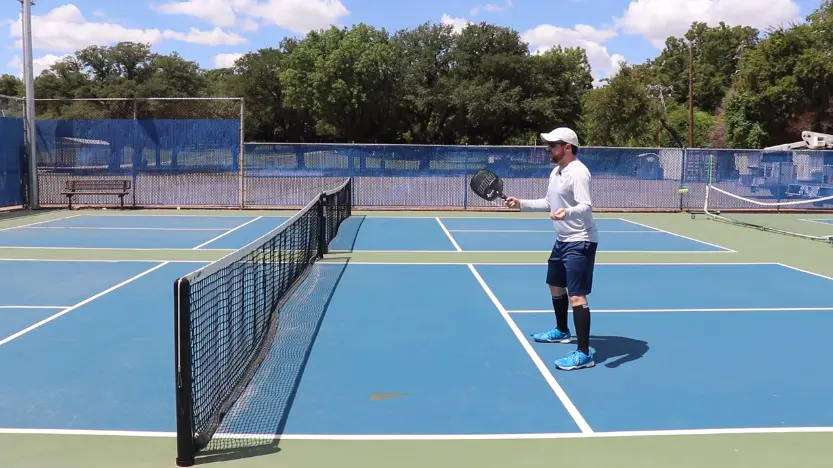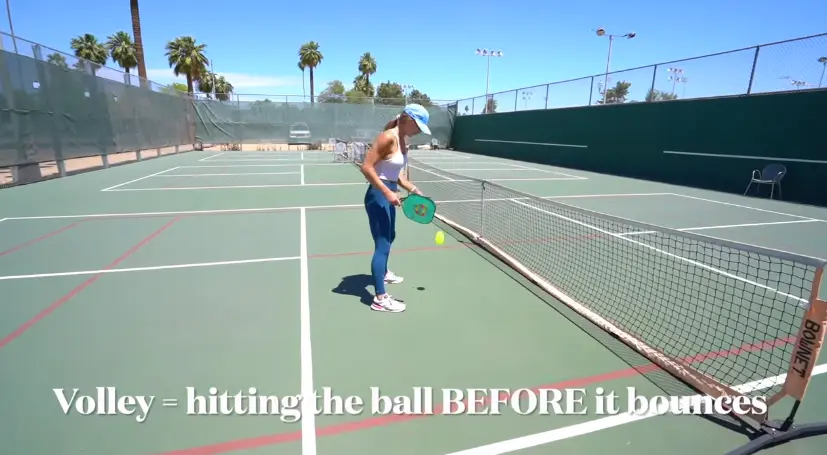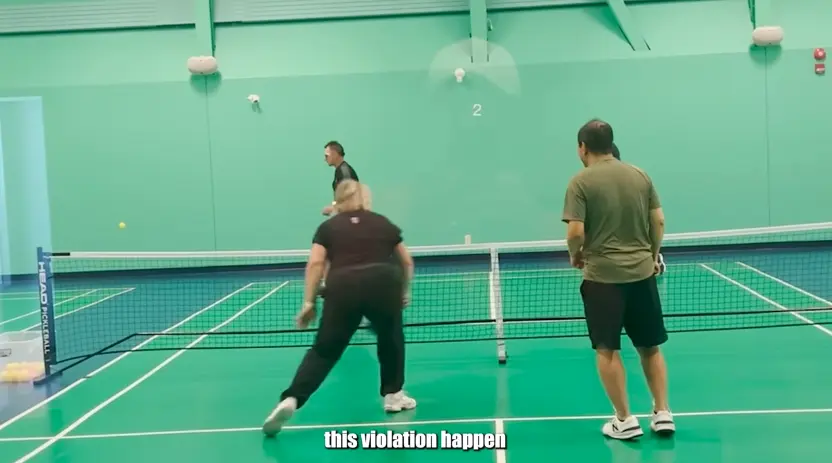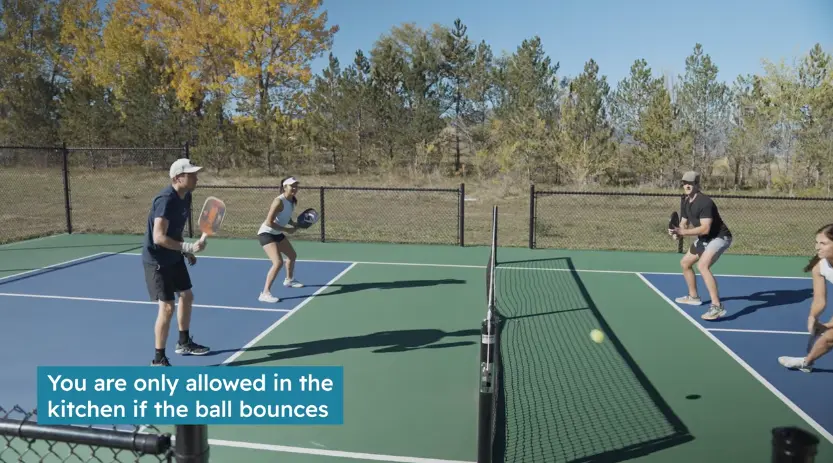Welcome to my article on the fascinating world of pickleball’s kitchen! Whether you’re a beginner or an experienced player, understanding the kitchen rules is crucial.
In this article, I aim to debunk the myths surrounding the kitchen and provide you with a comprehensive understanding of its rules. We’ll explore the nuances of the Non-Volley Zone (kitchen) and its most infamous rule while also shedding light on additional details.
By familiarizing yourself with the kitchen’s ins and outs, you’ll gain a competitive edge and improve your pickleball game. Let’s unravel the mysteries of the pickleball kitchen together!
Do Not Forget to Read: Overall Best Pickleball Paddles
What Is The Kitchen In Pickleball: Rules, Significance, and Strategy
The non-volley zone on each side of the net is a vital aspect of pickleball, commonly referred to as the kitchen. In this designated area, players are prohibited from volleying the ball.

The kitchen rule serves a crucial purpose in preventing players from dominating the game by continuously smashing every hit while standing at the net. Let’s delve into the details of the kitchen, including its dimensions, origin, rules, and significance in the world of pickleball.
The Kitchen: Defined Area and Origins
The kitchen is a section of the pickleball court that extends seven feet from both sides of the net and stretches from sideline to sideline.
While the exact origin of the term “kitchen” in pickleball remains unclear, some speculate that it was borrowed from shuffleboard, where a similar area is known as the kitchen.
In both sports, the kitchen can be an unfavorable spot, and players may face penalties for landing in this zone.
Crucial Rules and Fair Play
Understanding the kitchen’s rules is essential for fair play and maximizing your chances of success on the pickleball court.
According to the rules, players are not allowed to volley the ball within the kitchen boundaries while any part of their body is touching the kitchen surface. This rule applies to both feet and any objects or clothing connected to the player.

To legally volley above the kitchen, players must ensure that their feet (or any object/article of clothing they possess) are positioned behind the surface of the kitchen.
If a player finds themselves in the kitchen area, they must wait for the ball to cross outside the kitchen or bounce before hitting it. Failing to adhere to these rules results in a fault, potentially leading to the loss of a point or serve.
Significance in Strategy and Gameplay
The kitchen plays a vital role in maintaining balance and preventing players from gaining an unfair advantage at the net. By prohibiting players from volleying within the kitchen, the game remains dynamic and prevents individuals from dominating through constant smashes.
Understanding the intricacies of the kitchen allows players to strategize effectively, using the space to their advantage while adhering to the rules.
Beginners often struggle with the kitchen rule, as it requires discipline and spatial awareness. However, grasping this fundamental aspect of the game is essential for long-term improvement and fair competition.
The kitchen’s dimensions, which cover an area of 7 feet deep by 20 feet wide on each side of the net, are precisely defined within the overall measurements of the pickleball court.
Maintaining Flow and Fairness
The kitchen rule, though challenging, is crucial for maintaining the flow and fairness of pickleball matches. Violating the kitchen rule can result in losing a rally or conceding a point to the opposing team.
It adds a unique and challenging element to pickleball, setting it apart from other racket sports. Properly interpreting and following the kitchen rule not only ensures fair play but also enhances the overall enjoyment and competitiveness of the game.
Do Not Forget to Read: What is ATP in Pickleball
What is a Volley?
A volley in pickleball is an aggressive shot made before the ball bounces on one’s side of the court. It forces opponents to defend deep within their own territory.
There are two main types of volleys: forehand and backhand. Forehand volleys use an open paddle face for power and control, while backhand volleys utilize a closed paddle face for precise ball placement.

Volleys, also known as “overheads” or “smash shots,” can be executed from any position on the court except within the kitchen.
Despite existing in other paddle sports, volleys hold significant importance in pickleball. Mastering volleys adds variety, power, and precision to a player’s game, enhancing their ability to dominate rallies and outmaneuver opponents.
Do Not Forget to Read: How To Volley In Pickleball
Official Kitchen Rules of Pickleball
As with any sport, pickleball has its own set of rules that players must follow to ensure fair play and maintain the integrity of the game.
One crucial aspect of pickleball is the kitchen, also known as the non-volley zone (or NVZ for short), which has specific regulations that players need to adhere to.
Let’s explore the official kitchen rules of pickleball in detail:
Standing in the Kitchen:
- Players are allowed to stand anywhere in the kitchen as long as they do not volley the ball while standing in the non-volley zone.
- In doubles, it is generally recommended to position oneself around the kitchen line for optimal reach and positioning.
Misconceptions about the Kitchen:
- Many new players mistakenly believe that they should never step foot in the kitchen, but this is false.
- Players can step into the kitchen area but must ensure that both feet are outside of it before volleying the ball or allow the ball to bounce before hitting it.
Kitchen Line and the Non-Volley Zone Line:
- A pickleball serve cannot touch the kitchen line, including the demarcation line known as the non-volley zone line.
- It is against the kitchen rules to stand in or touch the kitchen while volleying the ball.
Faults in the Kitchen:

- Any contact with the ground within the kitchen area, including swinging, follow-through, or dropping items that fall into the kitchen, results in a fault.
- Momentum that carries a player into the kitchen during a volley is also considered a fault.
Dinking and Volleys:
- Short dinks that bounce in the kitchen can still be played by entering the kitchen, but volleys must be executed outside the non-volley zone.
- In doubles, your partner can be in the kitchen while you volley, as long as there is no contact between the players.
Volleys Outside the Non-Volley Zone:
- The official kitchen rules of pickleball state that all volleys must be hit from outside the non-volley zone.
- The kitchen rule prohibits players from standing in or making contact with the kitchen line during volleys.
Air Shots and Fault Risks:
- Hitting the ball out of the air while positioned behind the kitchen line is allowed but carries the risk of faulting due to another kitchen rule.
Dropping Items in the Kitchen:

- Dropping anything in the kitchen, including paddles, sunglasses, hats, or personal belongings, results in a fault for your opponent.
Momentum and Staying in the Kitchen:
- Momentum cannot carry players into the kitchen, even after successfully volleying the ball.
- While it is allowed to enter the kitchen to play a ball that has bounced inside, players should not stay there for an extended period to avoid giving their opponent an advantage.
Both Feet Outside the Kitchen:
- It is crucial to have both feet outside the kitchen before hitting a volley to comply with the kitchen rules.
Wheelchair Pickleball Rules:
- In wheelchair pickleball, volleying with the front wheels on or inside the kitchen line is allowed, but touching the line with the rear wheels during a volley is a fault.
Lines of the Kitchen:
- The lines outlining the edge of the kitchen are considered part of the kitchen itself, and volleying while touching those lines is prohibited.
No Touching the Kitchen:
- No part of the body or equipment can touch the kitchen during a volley.
- Crossing the plane of the kitchen line with the body or paddle is allowed as long as nothing touches the ground within the kitchen borders.
Doubles Partner and the Kitchen:
- Touching a doubles partner who is on the kitchen line while volleying the ball results in a fault.
Establishing Position Outside the Kitchen:
- Both feet must be on the ground outside the kitchen before hitting a volley.
- Quickly establishing both feet outside the kitchen after hitting a shot is important to avoid faults.
The Service Box and the Kitchen Line:
- The service box includes the kitchen line, center line, sideline, and end line.
- The kitchen line is considered “out,” and a serve must completely clear it to be valid, even if it grazes the net.
Understanding the official kitchen rules of pickleball is essential for all players, whether they are beginners or experienced competitors.
Adhering to these rules promotes fair play, prevents disputes, and ensures a thrilling and enjoyable pickleball match. So, step onto the court, play by the kitchen rules, and have a fantastic game of pickleball.
Do Not Forget to Read: How To Practice Pickleball Alone
Jumping and Landing in the Kitchen
While playing pickleball, players are allowed to jump and land in the kitchen with one exception: during the act of volleying. If a player jumps and lands in the kitchen while volleying the ball, it is considered a fault.
However, players can execute a volley over the kitchen by starting the jump outside the kitchen and landing outside the kitchen. This maneuver, known as an erne, is often performed near the sidelines, where players can jump diagonally and volley the ball in mid-air.
Entering the Kitchen and Shot Selection
Players are permitted to enter the kitchen at any point during a game, as long as they do not violate the volleying rules. Inside the kitchen, players have the freedom to hit various shots such as groundstrokes, dinks, and lobs.

However, it is crucial to ensure that the ball bounces first before striking it. This rule emphasizes the importance of control and strategy in executing shots from the kitchen.
What Is Dinking?
One of the key shots performed near the kitchen line is the dink. A dink is a soft shot that is aimed to land in the opponent’s kitchen, forcing them to let the ball bounce.
A well-placed dink can create scoring opportunities and keep opponents on their toes. By employing dinking techniques, players can maintain control of the game, prevent hard volleys or smashes from their opponents, and strategically attack when openings arise.
Dinking is considered a crucial aspect of pickleball and can significantly contribute to winning more points and games.
The Role of the Non-Volley Zone
The non-volley zone or kitchen plays a vital role in pickleball. It encourages players to develop better footwork, shot placement, and strategic thinking rather than relying solely on aggressive net play.

The kitchen rules prevent players from camping at the net and continuously smashing the ball back, leading to prolonged rallies and a more enjoyable playing experience for everyone involved.
Kitchen Rules and the Erne Shot in Pickleball
An advanced technique in pickleball is the erne shot, named after Erne Perry, who popularized the move in tournament play.
The erne shot allows a player to volley the ball outside the kitchen without violating the rules. By quickly shifting outside the sideline and volleying the ball as it approaches the kitchen, players can surprise their opponents and gain an advantage.
Mastering the erne shot requires skill and practice, but it can be a devastating move when executed effectively.
Tips for Dealing with the Kitchen
To effectively navigate the kitchen, players should familiarize themselves with a few key strategies. When returning a short dink, hopping into the kitchen is permitted as long as the ball has bounced first.
However, it is essential to be cautious as standing in the kitchen makes any subsequent volley a fault, so it is advisable to exit the kitchen promptly. Groundstrokes can be performed inside the kitchen, but the ball must bounce before striking it.
Positioning oneself a few inches behind the kitchen line, a concept known as “toeing the line,” helps players stay as close to the kitchen as possible without stepping into it. This positioning is particularly advantageous during consistent dinking rallies.
Advice from a Pro Player
Professional pickleball player Sarah Ansboury suggests toeing the line to maximize proximity to the kitchen. By positioning one’s feet a few inches behind the kitchen line, players can maintain their balance while remaining close enough to react swiftly to shots near the net.
For beginners, focusing on running up to the kitchen line during practice sessions can help develop better habits and adherence to the kitchen rules.
Over time, players will become more familiar with the kitchen’s location and develop a sense of when to engage and when to avoid stepping into it.
Improving Gameplay and Adhering to the Rules
Practicing positioning and becoming familiar with the kitchen’s boundaries are essential for improving gameplay and ensuring compliance with the rules.
Imagining an imaginary wall in front of the kitchen can help players mentally visualize the boundaries and avoid unintentional violations.
With practice and dedication, players can develop the necessary skills to effectively play near the kitchen, execute well-placed dinks, and strategically control the game.
A Helpful Guide: How Much Does It Cost To Build A Pickleball Court?
Final Word
In conclusion, understanding the kitchen in pickleball is crucial for players of all skill levels. By unraveling the myths and clarifying the rules surrounding the non-volley zone, players can improve their game and compete more fairly.
The kitchen serves a significant purpose in maintaining balance, preventing dominance at the net, and promoting strategic thinking. Mastering shots from the kitchen, such as dinks and volleys, adds variety and precision to gameplay.
Additionally, the erne shot offers an advanced technique for players to gain an advantage while staying within the rules.
By adhering to the kitchen rules, practicing proper positioning, and developing a sense of the boundaries, players can enhance their gameplay and enjoy the thrilling experience of pickleball.

Michael Stevenson
Hi, my name is Michael Stevenson and I’m a passionate pickleball player. I’ve been playing the game for many years and I’m pretty highly skilled at it. Pickleball is one of my favorite topics so naturally, I love to write about it.
Whether it’s tips for beginners, guides for experts, reviews of new paddles, or advanced playing techniques – if it relates to pickleball then I have something interesting to write about it. So if you’re looking for entertaining and informative information on the topic of pickleball, look no further than my written works!